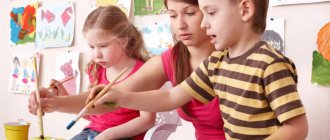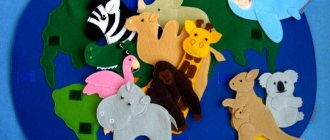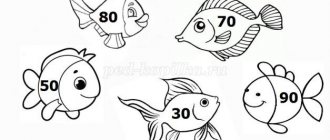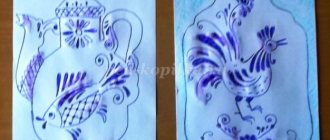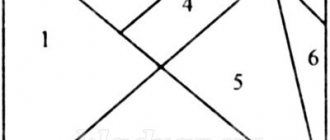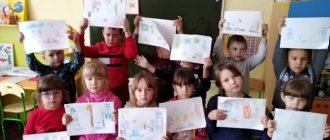Summary of educational activities in the preparatory group of kindergarten using ICT on the topic: Sports
Summary of direct educational activities in the preparatory group on the topic: “Experts in sports”
Author: Elena Valerievna Sozonova, teacher of MBOU Secondary School No. 95, Arkhangelsk. Description of work: I offer you a summary of direct educational activities for children in the preparatory group for school (6-7 years old) on the topic: “Sports Experts.” This material will be useful to teachers of the preparatory group. This summary of an educational lesson is aimed at cultivating interest in winter sports and developing the horizons of older preschool children.
Goal: expanding ideas about the surrounding reality by introducing children to winter sports. Objectives: Educational:
- give children an idea about the features of ice skates;
— to concretize children’s ideas about winter sports; — teach children to recognize and name sports, the necessary inventory, equipment, equipment for a given sport; select appropriate equipment for athletes. Developmental:
- promote the development of involuntary memory, logical thinking, attention, memory;
-develop sports terminology, the ability to use it in speech. Educational:
- formation of attitudes towards a healthy lifestyle;
— promotion of sports activities; Methodological techniques and methods: -verbal (reading and listening, active dialogue, questions, riddles); - visual (displaying a set of pictures depicting winter sports, multimedia presentation “Winter sports experts”); -game (games to develop logical thinking; sedentary games: “Winter fun” and “We are athletes”). Equipment and material: multimedia equipment, ball, pictures depicting sports, equipment (skis, 2 pairs of skates, stick, sled, racket), 2 hoops.
Progress of the lesson.
Introductory part: The teacher invites the children to the music room: Teacher: Good afternoon, dear friends! Today I propose to play an intellectual game called “Sports Experts”. Do you know who the experts are? (Children's answers). Now we will check. You are ready? The teacher draws attention to the sports equipment located on the table: skis, skates, racket, hockey stick, doll sled. Name what you see and how can these objects be called in one word? Children's answers: inventory. Educator: What equipment do you think is superfluous here? Why? Children's answers: Racket. Because we can use all the equipment except the racket in winter. Educator: Let's show how we like to have fun in winter. Physical education teacher: (movements according to the text) What do we like to do in winter? Playing snowballs, skiing, skating on ice, racing down the mountain on a sled. Main part: Educator: We have already talked about the fact that people actively spend time outside in winter. And this pastime has become for some people something more than just walking. Of course, I’m talking now about people who don’t just skate or ski, but compete, showing skill, achieve high results, and strive to win. Educator: What are these people called? Children's answers: Athletes. Educator: Each athlete has his own name. I invite you to play the game “Name the Athlete”. Children are asked to stand in a circle. Throwing the ball to you, I will name the sport, and you return it to me and name the athlete who plays it. - hockey - hockey player; - figure skating - figure skater; - skiing - skier; - speed skating - speed skater; - biathlon-biathlete. Children are asked to sit down and complete tasks. Educator: There are many types of sports, you can’t even count them all. We will now play, name sports. Demonstration of the presentation “Winter Sports Experts”. 1. Riddle-guess “Type of sport” (on the slide) And the athlete shoots at a target, And he races on skis. And the sport is called very simply…..(biathlon) I’ve heard a lot about this sport: Aerial acrobat On skis…(freestyle) There’s a game in the yard in the morning, The kids are playing around. Shouts: “puck!”, “past!”, “hit!” - So there is a game there - .... (hockey) Look: the skier rushes, And then flies like a bird, Having made a jump from the peaks. And the springboard helped him... (ski jumping) How huge it is, Our ice stadium. And the treadmill sparkles like a mirror. I won’t fall on it, I’ll be the first to reach the finish line!... (speed skating) Our artist is dancing on the ice, He’s not wearing a fur coat, he’s lightly dressed. And now the duet is on the ice. Eh, good skating! The audience held its breath. The sport is called... (figure skating) 2. Name the equipment (on the slide) - Helmet, stick, puck, skates. 3.Whose equipment? (on the slide) - Overalls, gloves, goggles, skis with poles and boots (biathlete). 4.Who and what is this? Lost and Found (on slide) -Goalkeeper, protection, gloves - trap, stick, puck (goal). 5.Who needs what? (on the slide) -Figure skater (ice and skates); -Skier (snow, skis); -Hockey player (helmet, stick, puck). The game “Who is doing what” (children are asked to tell, based on pictures depicting sports, what the athletes do). Children's answers: - Biathletes run on skis to the target, shoot at them with a rifle; -Skaters perform a dance on ice on skates; -Skaters run a race, covering a certain distance on an ice stadium in a closed circle; -Hockey players on the court try to score as many pucks as possible into the opponent’s goal by hitting it with their stick. Riddle game “Pretend to be an athlete.” The teacher invites the children to show the athlete’s movements, and for the rest of the children to learn and name the sport. The music “Come on Russia” is playing. 1. "Hockey". The hockey player performs sliding movements with holding the stick and hitting the puck, trying to hit the goal; the goalie hits the puck; 2. "Ski jumping." The child runs and long jumps. 3. "Biathlon" A child skis to the start, stops and pretends to shoot with a rifle; 4. “Figure skating.” Children perform sliding movements, depicting different figures (pair and single skating). Educator: Skiing requires snow and ... (skis), and what is needed for skating sports? (ice and skates). Educator: “Who needs what kind of skates?” For a hockey player - hockey; For a skater - figure skaters; For a speed skater - speed skating. Children are invited to sit down and pay attention to ice skates, demonstrating their different types (figure skates, hockey skates). Teacher's story: “Such different ice skates.” Each sport has its own shoe. Depending on the type of load, different blades are used, sharpening methods, even the appearance of the boot is different. There are 3 main types of skates: hockey, figure skating and speed skating. -Figure skates have a high boot with a heel and laces that rigidly fix the ankle. The tip of the blade has four teeth. These features help to draw figures on the ice. — In hockey skates, the boot is high, quite hard, and has hard inserts in the most open places. The toe of the boot is reinforced (it is made of plastic). This type of boot saves your feet from impact. The blades of the skates are curved, wide, and have no teeth. This allows you not to cling to the ice even during very sharp turns. -(on the slide) Speed skating shoes have low boots with laces. The blades have a lateral curvature. These features help you take turns faster on a small circle. Educator: Let's check if you remember which skates are needed. Game exercise “Dress up an athlete” (on the slide) 2 children invited to the screen on the slide show their choice of solving the issue (children see the effect of a positive result). Final part: Educator: You showed good results, like real athletes in the fight for victory. Now let's summarize our game. “Find and name an extra sport” (on the slide). -Skating, figure skating, hockey, cross-country skiing (cross-country skiing, since this sport requires skis, not skates). -Freestyle, cross-country skiing, ski jumping (ski racing, since sports such as freestyle and ski jumping require a springboard and do not require ski poles). Educator: All winter sports can be divided into two groups. Game "Don't make a mistake." Children are asked to assign pictures to sports based on the given sports equipment. (There are 2 hoops on the floor, one of them contains skates, and the other contains skis). Educator: Why did you make this choice? (children's answers). Educator: Name the types of skiing? Children's answers: cross-country skiing, biathlon, freestyle, ski jumping. Educator: Name skating sports? Children's answers: figure skating, speed skating, hockey. Educator: What does sport give to a person? Children's answers: sport makes a person strong, resilient, and improves health. Educator: What do you need to do to become an athlete? Children's answers: we need to do exercises and exercise. Fizkul We run with you on skis, The cold snow licks the skis. (children pretend to be skiing) And then we were on ice skates (they pretend to be skating) And then we were on a sleigh, (squat down) And then we made snowballs (they make snowballs) And they bombed the fortress. (imitate throws) We played enough, rode (jumping) And we gained health. (show strength) Educator: Well done!
You know winter sports well. I hope that you will be real athletes, experts in your field. The teacher gives the children “Sports Experts” medals. Presentation on the topic: Winter sports connoisseurs
We recommend watching:
Summary of educational activities for cognitive development in the preparatory group “Journey to the North” Summary of educational activities for children of the preparatory group “Types of Transport” Summary of cognitive activities in the preparatory group on the topic “Reservoirs” Summary of educational activities for children of senior preschool age (preparatory group). On the farm
Similar articles:
Summary of a lesson in the preparatory group on the topic: Rules of conduct in kindergarten
Life safety lesson “Rules of safe behavior on water.” Preparatory group
Who goes where: main group
In order to understand on what grounds they can be assigned to different groups, and also to determine how correct the assignment to a specific one was, it is worth taking a closer look at what the conditions for inclusion in all categories are. For example, the main one includes children characterized by:
- absence of health problems;
- mild violations.
The latter usually include:
- overweight;
- dyskinesia;
- mild allergic reactions;
- VSD.
Translation by vision
Myopia is a common disease in children starting from the age of three. If a child undergoes correctional treatment, then visual impairment up to -0.5 diopters becomes a recommendation for transferring him to the preparatory group. In other cases, myopia does not impose restrictions on physical education. The exception is children with progressive disease.
If vision drops to -6 diopters, the child is transferred to a special group.
The preparatory group is not a sentence. The child does not stay away from sports. As soon as his health returns to normal, he will be transferred to the main group.
If the doctor said so
When a doctor issues a certificate to a child confirming his enrollment in a preparatory physical education group, he indicates what should not be done in the document and explains in words in more detail and intelligibly. Surprisingly, not only children, but also their parents, as well as teachers, do not always pay enough attention to this. You should be aware: if doctors have noted contraindications, restrictions, and the time allowed for classes, you must follow these rules so as not to encounter a deterioration in the child’s condition. The groups should not be confused: whichever is stated in the certificate is the same. Preparatory education is indicated - this is not a reason to panic and completely prohibit the child from appearing in physical education, because the lack of thematic education negatively affects health, future opportunities and even self-awareness.
